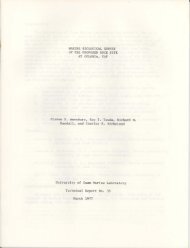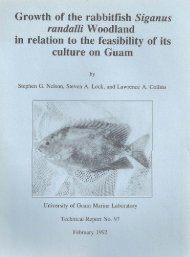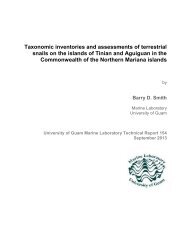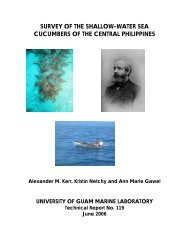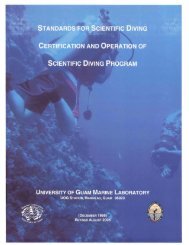Marine Protected Area Surveys Central Visayas, Philippines 2007
Marine Protected Area Surveys Central Visayas, Philippines 2007
Marine Protected Area Surveys Central Visayas, Philippines 2007
You also want an ePaper? Increase the reach of your titles
YUMPU automatically turns print PDFs into web optimized ePapers that Google loves.
Raymundo and Maypa 2008 UOG Tech. Rep. 122<br />
grounds (51.1%), though complexity was similar in both areas. Coral cover was lower inside the<br />
MPA than the previous year (2006: 60%), though cover was much higher outside than the year<br />
before (2006: 11%). However, it is doubtful that the substantially higher coral cover value<br />
obtained in <strong>2007</strong> in the fishing ground is due to coral growth and recruitment. We speculate that<br />
this large difference may have been due to the placement and number of replicate transects.<br />
The <strong>2007</strong> transects may be more representative of the reef as a whole, as a greater number of<br />
transects were read during this second survey. Massive corals of the family Faviidae were very<br />
common on this reef crest, with more fragile branching morphologies occurring slightly deeper.<br />
These figures did not change significantly from the 2006 surveys. The fishing ground showed<br />
much more damaged and dead coral, macroalgae, and corallivores (Drupella). Fish diversity,<br />
however, was very high both in and out of the MPA; the calculated values were almost the same<br />
(Fig. 6; Fig. 11). Such high diversity even within the fishing ground may reflect a recovery of the<br />
fish assemblage due to a decrease in fishing pressure, as more fishers have become involved<br />
in the tourism trade. The visibly greater damage to the reef outside of the MPA boundaries,<br />
however, suggests that much of the damage may have been from past fishing activities, or<br />
tourism-related activities.<br />
As with Balicasag, Gilutungan exhibited very low mean total disease prevalence in 2006<br />
surveys (0.54% in the MPA; 0.83% in the fishing grounds). One year later, prevalence had<br />
markedly increased (2.7% in the MPA; 4.5% in the fishing grounds). The pattern of lower<br />
prevalence within the MPA still held, however. White syndrome was the most common disease;<br />
skeletal eroding band and patchy bleaching were less common, but consistently found along our<br />
transects. Coralliophila and Drupella predation were observed in both areas, though the<br />
gastropods were more common in the fishing grounds.<br />
The potential for tourism-related damage was quite high, given the volume of tourists<br />
that visit the site on a daily basis. From our observations, most tourists do not possess good<br />
water skills, and breakage of corals from physical contact with boats and swimmers may be a<br />
significant source of coral damage. In addition, we heard an average of 10 dynamite blasts per<br />
hour from nearby islands during our morning dives. It is clear that the fisher’s management<br />
organization needs continued vigilance and support from local government to continue to<br />
protect this reef.<br />
15





